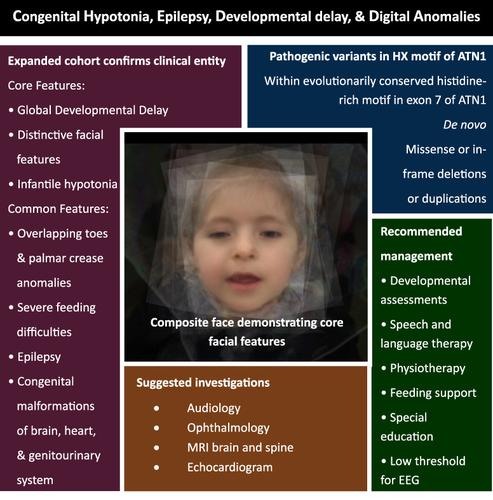当前位置:
X-MOL 学术
›
Clin. Genet.
›
论文详情
Our official English website, www.x-mol.net, welcomes your
feedback! (Note: you will need to create a separate account there.)
CHEDDA syndrome is an underrecognized neurodevelopmental disorder with a highly restricted ATN1 mutation spectrum
Clinical Genetics ( IF 2.9 ) Pub Date : 2021-07-01 , DOI: 10.1111/cge.14022 Elizabeth E Palmer 1, 2 , Chloe Whitton 3 , Mais O Hashem 4 , Robin D Clark 5 , Subhadra Ramanathan 5 , Lois J Starr 6 , Danita Velasco 6 , John Karl De Dios 7 , Emily Singh 8 , Valerie Cormier-Daire 9 , Maya Chopra 10 , Lance H Rodan 11 , Christoffer Nellaker 12, 13, 14 , Shenela Lakhani 15 , Eric J Mallack 15 , Karin Panzer 16 , Alpa Sidhu 16 , Ingrid M Wentzensen 17 , Didier Lacombe 18, 19 , Vincent Michaud 18, 19 , Fowzan S Alkuraya 4
Clinical Genetics ( IF 2.9 ) Pub Date : 2021-07-01 , DOI: 10.1111/cge.14022 Elizabeth E Palmer 1, 2 , Chloe Whitton 3 , Mais O Hashem 4 , Robin D Clark 5 , Subhadra Ramanathan 5 , Lois J Starr 6 , Danita Velasco 6 , John Karl De Dios 7 , Emily Singh 8 , Valerie Cormier-Daire 9 , Maya Chopra 10 , Lance H Rodan 11 , Christoffer Nellaker 12, 13, 14 , Shenela Lakhani 15 , Eric J Mallack 15 , Karin Panzer 16 , Alpa Sidhu 16 , Ingrid M Wentzensen 17 , Didier Lacombe 18, 19 , Vincent Michaud 18, 19 , Fowzan S Alkuraya 4
Affiliation

|
We describe the clinical features of nine unrelated individuals with rare de novo missense or in-frame deletions/duplications within the “HX motif” of exon 7 of ATN1. We previously proposed that individuals with such variants should be considered as being affected by the syndromic condition of congenital hypotonia, epilepsy, developmental delay, and digital anomalies (CHEDDA), distinct from dentatorubral-pallidoluysian atrophy (DRPLA) secondary to expansion variants in exon 5 of ATN1. We confirm that the universal phenotypic features of CHEDDA are distinctive facial features and global developmental delay. Infantile hypotonia and minor hand and feet differences are common and can present as arthrogryposis. Common comorbidities include severe feeding difficulties, often requiring gastrostomy support, as well as visual and hearing impairments. Epilepsy and congenital malformations of the brain, heart, and genitourinary systems are frequent but not universal. Our study confirms the clinical entity of CHEDDA secondary to a mutational signature restricted to exon 7 of ATN1. We propose a clinical schedule for assessment upon diagnosis, surveillance, and early intervention including the potential of neuroimaging for prognostication.
中文翻译:

CHEDDA 综合征是一种未被充分认识的神经发育障碍,具有高度受限的 ATN1 突变谱
我们描述了九个无关个体的临床特征,这些个体在ATN1外显子 7 的“HX 基序”内具有罕见的从头错义或框内缺失/重复。我们之前提出,具有此类变异的个体应被视为受到先天性肌张力减退、癫痫、发育迟缓和指异常 (CHEDDA) 的综合征状况的影响,这与继发于外显子 5 中的扩张变异的牙颌-苍白球萎缩 (DRPLA) 不同ATN1的. 我们确认 CHEDDA 的普遍表型特征是独特的面部特征和整体发育迟缓。婴儿肌张力减退和轻微的手足差异很常见,可表现为关节弯曲。常见的合并症包括严重的喂养困难,通常需要胃造口术支持,以及视力和听力障碍。脑部、心脏和泌尿生殖系统的癫痫和先天性畸形很常见,但并不普遍。我们的研究证实了 CHEDDA 的临床实体继发于 ATN1 外显子 7 的突变特征。我们提出了一个临床计划,用于评估诊断、监测和早期干预,包括神经影像学预测的潜力。
更新日期:2021-09-03
中文翻译:

CHEDDA 综合征是一种未被充分认识的神经发育障碍,具有高度受限的 ATN1 突变谱
我们描述了九个无关个体的临床特征,这些个体在ATN1外显子 7 的“HX 基序”内具有罕见的从头错义或框内缺失/重复。我们之前提出,具有此类变异的个体应被视为受到先天性肌张力减退、癫痫、发育迟缓和指异常 (CHEDDA) 的综合征状况的影响,这与继发于外显子 5 中的扩张变异的牙颌-苍白球萎缩 (DRPLA) 不同ATN1的. 我们确认 CHEDDA 的普遍表型特征是独特的面部特征和整体发育迟缓。婴儿肌张力减退和轻微的手足差异很常见,可表现为关节弯曲。常见的合并症包括严重的喂养困难,通常需要胃造口术支持,以及视力和听力障碍。脑部、心脏和泌尿生殖系统的癫痫和先天性畸形很常见,但并不普遍。我们的研究证实了 CHEDDA 的临床实体继发于 ATN1 外显子 7 的突变特征。我们提出了一个临床计划,用于评估诊断、监测和早期干预,包括神经影像学预测的潜力。











































 京公网安备 11010802027423号
京公网安备 11010802027423号